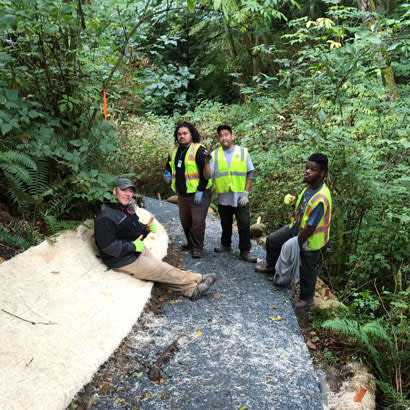
“Take me to the salmon!” is surely going to be among the screams and cheers heard from the students of Viewlands Elementary in Seattle, Washington, this fall as they enter Carkeek Park, via the new Viewlands Trail reroute that was built this past summer. The Viewlands trail has been the main pedestrian entrance not only for school kids, but also for the greater community east of 3rd Avenue NW and North of NW 105th Street in Northwest Seattle.
Carkeek Park is home to an urban area that sees salmon return to spawn yearly and is an environmental education gem, especially for the students and teachers of Viewlands Elementary. It is also one of Seattle’s best-known destination parks, known for its amazing network of trails and stunning wide-open sandy beach. The issue is that there is only one road into the park, and it has no sidewalks. The other formal entrance to the park is at its southern tip, which makes the Viewlands Trail entrance very critical to the adjacent neighbors and pedestrians.
Creating a More Sustainable Reroute
The existing trail was last upgraded in 1999 with a magnificent set of timber steps; however, due to the geology of the site along with perpetual water, they have served their lifespan. With the addition of the Meet Me at The Park grant funding from NRPA, proactive steps can now be taken to create a much more sustainable reroute prior to the eventual failure of the existing structure.
Once we were awarded the grant, planning the reroute turned into a truly collaborative effort. With our busy summers and existing programs and with a September 15 deadline for the completion of the work, the project schedule was very tight. Before work could start, the plan needed to be reviewed and vetted by Seattle Parks & Recreation (SPR) Planner David Graves and SPR GeoTech Scott Stevens. Graves ensures that projects are following our environmental policies and regulations, and with the reroute taking place in a riparian (creek) zone, it was important to ensure we followed all the best management practices for work on sites such as this. Stevens made sure the soils and geology of the area were conducive to the proposed project, and we all learned a lot about the variety of soil types in the area.
As soon as the ink was dry on our work permit, we scheduled work parties with our partners, Seattle Trails Alliance and the Washington Trails Association. We held a total of five work parties that included more than 80 volunteers contributing more than 500 service hours. Volunteers from the neighborhood and from companies like REI and Amazon performed some of the most arduous tasks, such as moving crushed rock via bucket brigade over difficult terrain.
Although volunteers were critical to the completion of the project, the bulk of the work was completed by Seattle Parks and Recreation staff. The greatest effort came from the Northwest District and crew chief, Brian Ta. In addition to the work needed to complete the project, the normal tasks of mowing turf, cleaning restrooms, emptying garbage cans and the overall business of parks, during the busiest time of the year, still had to be done. The Northwest District staff, along with a final push from the Natural Area Crew staff, got this project done, on time and on budget.
Getting Feedback
The true joy of this project was seen in November, when the salmon returned to the creek and members of the community along with students from Viewlands Elementary could enjoy safe, enhanced access to the park. As the usage of the new trail increased, we received many kudos, feedback and suggestions from parents and community members. A couple of these suggestions called for adding railing along portions of the trail and installing some additional steps. The new trail follows grade adjacent to a tributary of Pipers Creek, and some trail users found it to be a bit steep.
Carkeek Park is home to “Sound Steps,” one of its flagship programs that caters to those more than 65 years old and that encourages a healthy, active lifestyle by walking in the park. It was the members of this group who requested the installation of a few more check steps to the trail, much to the chagrin of the Viewlands Elementary students who like to “fly” down the trail unimpeded by the steps. The students’ chaperones and teachers were the ones who requested railing be added at one of the switchbacks, which has a short drop off below it. The park’s metal shop fabricated and galvanized a new metal railing, which was installed along the section of the trail in question.
Seattle is fortunate to enjoy large green spaces across the city in parks like Carkeek. Creating safe, equitable access for the largest amount of people is an important aspect of managing trails, especially in urban environments where traffic can be as high as thousands of people per month. With salmon bearing creeks, old growth forest, nesting eagles, and a variety of wildlife, it is important to have directed use via a well-built, well-maintained trails system. Trails also protect these assets and get our community members where they want to go. Most of the users of the new trail are in the park for recreation and education; however, we cannot forget those who use the trails for transportation. Our urban green spaces serve as buffers between neighborhoods and trails serve as the connection between communities.
So, if you get a chance to visit Carkeek Park and the new section of the Viewlands trail, you most certainly will see young people whipping up and down the trail and, perhaps, Sound Steppers moving gingerly along and joggers running the trail. You will also see neighbors returning from the grocery story, happy to be able to walk in the forest instead of along a busy street.
Thank you, NRPA.
Chukundi Salisbury is the Trails Coordinator for the City of Seattle Washington.

